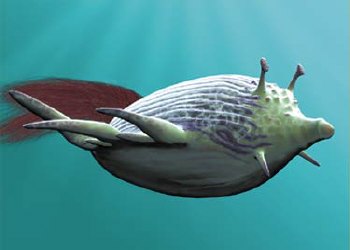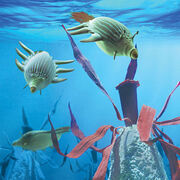
The reef glider is a massive, omnivorous nudibranch from the Shallow Seas in 100 million AD, in The Future is Wild.
The large form of a reef glider can often be seen sweeping through the water, silhouetted against the bright surface and throwing its shadow across a red alga reef. From its bulbous, teardrop-shaped body protrude three pairs of paddles. A long bunch of streamer-like filaments trails behind. It is difficult to believe that this is a variety of nudibranch, bigger than any of its relatives. During previous times, they were unflatteringly called sea slugs but, despite their ugly common name, they have been dainty-looking creatures, colorful and elegant, their gills forming fernlike arrays on their backs.
100 million AD, nudibranchs have evolved into substantial animals, with adult reef gliders growing to the size of seals. Like their ancestral relatives, they are brightly colored, their gills flowing behind them in a long train of silky fibrous plumes, like the tail of certain birds of paradise. The reef glider's head sports a pattern of bumpy, scent-detecting chemical receptors, called rhinophores, and groups of eye

An adult reef glider, its gills flowing behind in a colorful display, paddles gently through the greenish, sun-infused waters of the algal reefs.
s mounted on stalks. It has a horny, beaklike mouth. Unlike its relatives, the reef glider no longer relies on simply crawling across a reef by expanding and contracting its body. It has developed paddles, which are fleshy extensions of its invertebrate body. Each pair beats in turn, propelling the animal slowly through the water.
To swim efficiently and to save energy, a large, slow-moving marine animal needs to be neutrally buoyant (able to float effortlessly through the water). Bony fish achieve this using their gas-filled swim bladder. Sharks keep their bodies lighter than seawater by means of low-density oils in their tissues. The reef glider's method is more sophisticated. By replacing the heavy sodium ions in its bodily fluids with lighter ammonium ions, the reef glider becomes lighter than the water around it. Staying buoyant requires large quantities of ammonium-rich fluid, hence the glider's bloated shape.
Adult reef gliders spend most of their lives in open water, coming to the reefs to breed and to give birth. The algal reefs are a secure nursery for the baby reef gliders, which derive most of their nutrition from red algae. The juveniles are like smaller,

Young reef gliders dart among the jagged peaks of an algal reef, feeding from the flowerlike protuberances.
faster and more brightly colored versions of their parents. They flit about the surface of the reefs, extending their long mouths into the cup-shaped structures form by the reef algae.
In the base of the cups, the algae produce deposits of protein and carbohydrate. The bay reef gliders' beaked mouths reach into the cups to gather food. As they emerge, they are coated with sticky strands of reproductive gamete cells. These are carried across to another cup and scraped off as the young animal feeds. Like bees, the baby reef gliders are acting as fertilizing agents for the algae. Juvenile reef gliders are the ultimate vector animal for red algae, and have been for millions of years.
Monumental reef structures, graced with pretty algal fronds and flowerlike appendages, live in harmony with the elegant young reef gliders.
As young reef gliders cruise and gyrate among the red algae, they can at times become prey. An ocean phantom colony might just snatch a baby glider (sometimes it will be drawn to the jellyfish by its own curiosity) and devour it.
Adult reef gliders which, as juveniles, were prey to the ocean phantom, are now its chief predator. As they move into adulthood, reef gliders must leave the reefs in search of a larger source of protein. The ocean phantom is at the top of the menu. Circling their victim like slow-moving sharks, the reef gliders home in on the floating mass. Their horny beaklike mouths tear into the air sacs, tentacles, the rudders and the keels (in fact, every part of the ocean phantom beneath the waterline is a potential meal for an adult reef glider). Chunks bitten from an ocean phantom are the adult gliders' main food supply. In the face of such an assault, the phantom's symbiotically-living spindletroopers will rush to its defense and fend off an attacking reef glider by nipping at it.
Trivia[]
The hunting on ocean phantoms by adult reef gliders may have been inspired from the pelorus from The New Dinosaurs: An Alternative Evolution.
|
|||||||||
